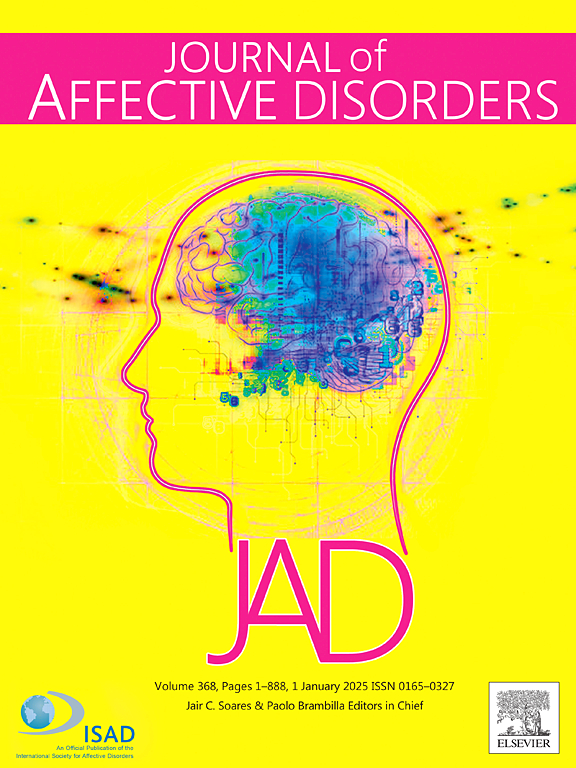空气污染是精神疾病的危险因素:一项两步孟德尔随机研究。
IF 4.9
2区 医学
Q1 CLINICAL NEUROLOGY
引用次数: 0
摘要
背景:根据流行病学证据,环境空气污染是一种重大的环境健康威胁,已显示有精神疾病的风险。然而,空气污染物与精神疾病之间的因果关系尚不清楚。方法:披露的影响空气污染(包括二氧化氮(NO2, n = 456380),颗粒物2.5 n = 423796],和PM2.5吸光度[n = 423796])在精神疾病(自闭症谱系障碍(ASD, n = 46351),注意缺陷多动症(ADHD, n = 55374),焦虑症(焦虑感,n = 17310)精神分裂症(SCZ n = 127906)和重度抑郁症[MDD, n = 500199]),孟德尔随机化(先生)进行了分析。脑成像表型的中介作用也被访问(n = 8428)。结果:MR分析显示PM2.5对MDD有显著影响(OR = 1.260,95 % CI: 1.077 ~ 1.474, P = 0.004),其部分作用由左ca4体体积介导(6.18 %),被右半球包裹的额极灰白色对比所掩盖(4.71 %)。我们还观察到PM2.5吸光度与ADHD之间的显著关系(OR = 2.018,95%CI: 1.250-3.258, P = 0.004),这被rfMRI连通性(ICA100边缘25)(13.27 %)所掩盖。此外,我们发现NO2(或 = 1.511,95 % CI: 1.069 - -2.136, P = 0.020)或PM2.5吸光度(或 = 1.595,95 % CI: 1.078 - -2.361, P = 0.020)增加自闭症的风险。此外,NO2与SCZ (OR = 1.494,95%CI: 1.104 ~ 2.022, P = 0.009)、PM2.5与ANX (OR = 2.431,95%CI: 1.207 ~ 4.898, P = 0.013)存在相关性。结论:研究结果揭示了空气污染与精神疾病之间的遗传因果关系,这种关系被脑成像表型介导或掩盖。这些结果可能为空气污染介导的精神障碍的机理和临床研究提供见解。本文章由计算机程序翻译,如有差异,请以英文原文为准。
Air pollution is the risk factor for psychiatric disorders: a two-step Mendelian randomization study
Background
Ambient air pollution, a significant environmental health threat, has been shown to risk psychiatric disorders according to epidemiological evidence. However, the causal relationships between air pollutants and psychiatric disorders remain unclear.
Methods
To reveal the impact of air pollution (including nitrogen dioxide [NO2, n = 456,380], particulate matter <2.5 μm [PM2.5, n = 423,796], and PM2.5 absorbance [n = 423,796]) on psychiatric disorders (autism spectrum disorders [ASD, n = 46,351], attention-deficit/hyperactivity disorder [ADHD, n = 55,374], anxiety disorders [ANX, n = 17,310], schizophrenia [SCZ, n = 127,906], and major depressive disorder [MDD, n = 500,199]), the Mendelian Randomization (MR) analysis was conducted. The mediating effects of brain imaging phenotypes were also accessed (n = 8428).
Results
MR analysis indicated a significant effect of PM2.5 on MDD (OR = 1.260, 95 % CI: 1.077–1.474, P = 0.004), which was partially mediated by the volume of left CA4-body (6.18 %) and masked by the grey-white contrast in frontalpole in the right hemisphere parcellation (4.71 %). We also observed that the significant relationship between PM2.5 absorbance and ADHD (OR = 2.018, 95%CI: 1.250–3.258, P = 0.004), which was masked by rfMRI connectivity (ICA100 edge 25) (13.27 %). Furthermore, we discovered that NO2 (OR = 1.511, 95 % CI: 1.069–2.136, P = 0.020) or PM2.5 absorbance (OR = 1.595, 95 % CI: 1.078–2.361, P = 0.020) increased the risk of ASD. In addition, there were associations between NO2 and SCZ (OR = 1.494, 95%CI: 1.104–2.022, P = 0.009) as well as PM2.5 and ANX (OR = 2.431, 95%CI: 1.207–4.898, P = 0.013).
Conclusion
The findings revealed genetic causal relationships between air pollution and psychiatric disorders, mediated or masked by brain imaging phenotypes. These results may provide insights for mechanistic and clinical research on air pollution-mediated psychiatric disorders.
求助全文
通过发布文献求助,成功后即可免费获取论文全文。
去求助
来源期刊

Journal of affective disorders
医学-精神病学
CiteScore
10.90
自引率
6.10%
发文量
1319
审稿时长
9.3 weeks
期刊介绍:
The Journal of Affective Disorders publishes papers concerned with affective disorders in the widest sense: depression, mania, mood spectrum, emotions and personality, anxiety and stress. It is interdisciplinary and aims to bring together different approaches for a diverse readership. Top quality papers will be accepted dealing with any aspect of affective disorders, including neuroimaging, cognitive neurosciences, genetics, molecular biology, experimental and clinical neurosciences, pharmacology, neuroimmunoendocrinology, intervention and treatment trials.
 求助内容:
求助内容: 应助结果提醒方式:
应助结果提醒方式:


